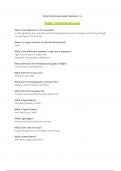Patho
Final
Study
Guide:
Modules
1-4
Module
1:
Cell
Structure
&
Function
What
is
the
definition
of
homeostasis? A
self-regulating,
give-and-take
system
that
responds
to
minor
changes
in
the
body
through compensatory
mechanisms.
What
is
a
major
indicator
of
altered
homeostasis? Fever
What
is
the
difference
between
a
sign
and
a
symptom? Signs
can
be
seen
or
measured. Symptoms
are
a
patient
description.
What
chemicals
are
released
during
fight
or
flight? Cortisol
and
catecholamines.
What
does
the
nucleus
do? Store
the
cell’s
DNA
What
does
the
endoplasmic
reticulum
do? Makes
proteins
that
the
cell
needs.
What
does
the
nucleolus
do? Produce
and
assemble
the
cell’s
ribosomes.
What
is
hyperplasia? Increased
number
of
cells
What
is
hypertrophy? Increased
size
of
cells
What
is
glucagon? A
hormone
that
is
formed
in
the
liver
What
is
the
role
of
insulin? It
grabs
the
glucose
and
brings
it
into
the
cell.
What
causes
edema? Decrease
in
plasma
proteins. Module
2:
Fluid
&
Electrolyte
Balance
Where
is
the
intracellular
fluid
found?
Inside
the
cells
What
is
intracellular
rich
in?
Magnesium
and
potassium.
THINK
MPPP
(magnesium,
potassium,
phosphorus,
protein)
Where
is
the
extracellular
fluid
found?
Outside
the
cells.
How
is
extracellular
fluid
divided
up?
(ECF
=
80%
interstitial
&
20%
plasma)
Interstitial
fluid
and
intravascular
fluid
Electrolyte
Norms/Ranges:
Sodium:
135-145
mEq/L
Chloride:
98-108
mEq/L
Magnesium:
1.8-2.4
mEq/L
Calcium:
8.6-10.2
mg/dL
Potassium:
3.5-5
mEq/L
Phosphorous:
2.5-4.5
mg/dL
What
part
of
the
body
does
sodium
affect?
The
brain
What
part
of
the
body
does
potassium
affect?
The
heart
&
kidney
Where
is
our
electrolyte
pool
and
storage?
Bones
What
is
hypervolemia?
Excess
fluid
in
the
intravascular
space
What
would
a
patient
look
like
with
hypervolemia?
Peripheral
edema,
bounding
pulse,
tachycardia,
jugular
vein
distention,
hypertension,
rapid
weight
gain,
bulging
fontanelles,
dyspnea What
is
hypovolemia?
Decreased
fluid
in
the
intravascular
space.
What
does
a
patient
look
like
with
hypovolemia?
Thirst,
hypotension,
tachycardia,
weak
&
thready
pulse,
dry
mucus
membranes,
flat
jugular
veins,
altered
level
of
consciousness.
What
is
hypertonic?
Higher
solute,
causing
fluid
to
shift
IN
What
is
hypotonic?
Lower
solute,
causing
fluids
to
shift
OUT
What
is
isotonic?
Equal
solute,
NO
fluid
shifts
(ISO-perfect)
Isotonic
can
also
be…
Normal
saline
&
lactated
ringers
What
is
osmosis?
Passive
movement
of
water/solvent
across
the
cell
membrane
to
a
higher
concentration.
What
is
diffusion?
Particles
move
from
an
area
of
high
concentration
to
an
area
of
low
concentration
until
equilibrium
is
reached.
ABG
Normal
Values:
pH:
7.35-7.45
PaCO2:
45-35
HCO3:
22-26
PaO2:
90-100
Hint:
if
your
pH
is
with
PaCO2
it's
respiratory
Hint:
if
your
pH
is
with
HCO3
it’s
metabolic What
is
respiratory
acidosis?
The
result
of
carbon
dioxide
retention
increases
carbonic
acid.
What
does
a
patient
look
like
with
respiratory
acidosis?
Hypoventilation,
hypotension
with
vasodilation,
rapid
shallow
respirations,
hyperkalemia,
elevated
potassium
level,
drowsiness,
dizziness,
hyperreflexia,
dyspnea
(labored
breathing)
–
pH
is
below
7.35
&
PaCO2
is
above
45
–
What
can
cause
respiratory
acidosis?
Drug
overdose,
COPD,
pneumonia,
asthma
What
is
respiratory
alkalosis?
Result
of
excess
exhalation
of
carbon
dioxide,
which
leads
to
carbonic
acid
deficits.
What
does
a
patient
look
like
with
respiratory
alkalosis?
Deep,
rapid
breathing,
hyperventilation,
tachycardia,
hypotension
(or
normal
BP),
hypokalemia,
numbness
&
tingling,
lethargy,
and
confusion.
What
can
cause
respiratory
alkalosis?
Hyperventilation,
anxiety,
fear,
PE,
or
mechanical
ventilation.
Cell
Type
&
Functions:
Neutrophils
-
the
first
to
arrive
on
the
scene
Basophils
-
bind
to
IgE
and
release
histamine
in
anaphylaxis
Eosinophils
-
allergic
reactions
that
cause
rhinorrhea
Monocytes
-
respond
to
inflammation
by
migrating
to
the
infected
area
Lymphocytes
-
mainly
found
in
lymph;
B
cells,
T
cells,
&
killer
cells
Macrophages
-
produced
by
monocytes;
they
phagocytize
(eat)
&
stimulate
lymphocytes
to
respond
to
pathogens
Plasma
Cells
-
develop
from
B
cells
Mast
Cells
-
connective
tissue
cells
that
release
histamine




